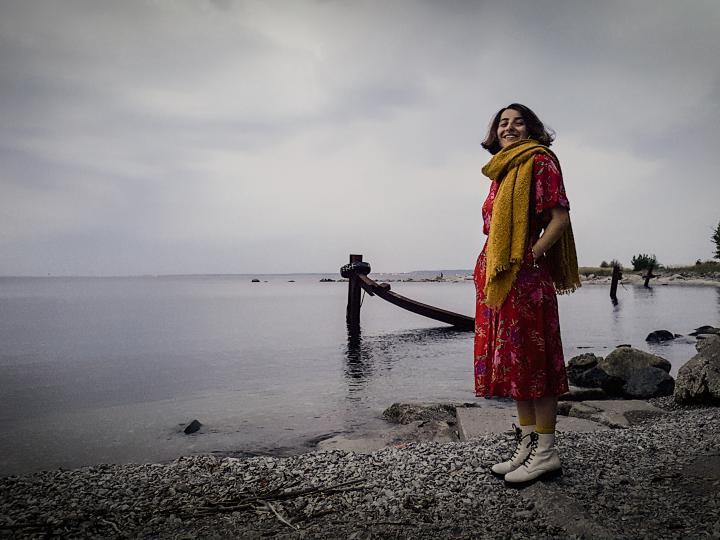
It all started with Google and a book: Arife Dila Demir has discovered Estonia’s international study opportunities by chance. “I have heard of Estonia before, but mostly from my friends who work in the IT sector. I never thought I would find something of interest for me here”, Dila begins her story. “At the time, I was actively searching for master’s programmes to switch my career path from Interior Architecture to Textile Design”. One day, she came across a book edited by a staff member of the Estonian Academy of Arts (Eesti Kunstiakadeemia, EKA) in Tallinn. “It sounded exciting and made me wonder what study opportunities Estonia could offer. That’s how I decided to pursue an MA in Textile Design at EKA. In the long term, Estonia has also proved to be an affordable place to live and study, so it worked out as a great chance”.
Coming to Estonia
From the very beginning, the travel adaption hasn’t been much of an issue. “I didn’t know anything about Estonia before and came here with an open mind, ready to explore a foreign culture and another way of living. Coming from Turkey, such a different cultural background, I soon came to enjoy Estonia’s slow life with so much less population and much more space to yourself”, Dila recalls. Indeed, many international students admit: Estonia has a very calming and homely atmosphere; there’s never a rush, even if you live in the capital city. Thanks to that, the probability of a culture shock remains rather insignificant.
Estonian Academy of Arts and e-textiles
“Because of my architectural background, I first wanted to learn more about the traditional techniques of craftsmanship and textile-making, and what role modern technology plays in it”, Dila explains. “My experience at EKA turned out to be amazing: it provided me with the opportunity to express myself, not just receive a formal education”.
In 2019, Dila graduated with a master’s degree in Textile Design and entered a Ph.D. programme at the same university. “Ever since the start of my MA course, I intended to pursue an academic career as a researcher”, Dila says. “EKA announces a public call for doctoral candidates on an annual basis so that anyone can apply”. Dila’s doctoral research works as a continuation of her master’s thesis on interactive textiles or e-textiles. Textile products can function as sensors and produce various heat or light reactions when integrated with electronic components. “In my MA research, I have combined these things and created interactive woven light-emitting artifacts that pushed the boundaries of the creative environment and our interaction with it”, Dila explains. “For my Ph.D. studies, I am also exploring the potential of e-textiles and possibilities for their implementation. It’s a fast-growing field, only limited by our imagination. Textile surrounds human bodies everywhere, and by integrating electrical components into it, you can see how those two interact with one another”.
In 2019 and 2020, Dila participated in the artistic project of Dr. Ellen Pearlman, supported by the European Commissions’s STARTS programme – a combination of arts, technology, and innovation. In collaboration with Tallinn University, Dr. Pearlman’s project, titled as AIBO: A. I. Brainwave Opera, premiered in Tallinn in February 2020. Dila herself has designed a costume connected to an EEG Headset (electroencephalogram – a test that detects the brain’s electrical activity), which controlled the lights embedded into the fabric depending on the emotional state of the performer. “It’ has been an amazing experience working with this group”, Dila says. “We watched the emotions displayed on the costume and the environment created on stage, while the audience observed the communication between the AI and the costume”.
As a lecturer, Dila has recently participated in a project connecting four institutions: Tallinn University, it’s Baltic Film, Media, Arts and Communication School, EKA, and Estonian Academy of Music and Theatre. Students who represented every university, or department, were divided into groups aiming to develop an intersectional performance. “It was a great teaching experience”, she recalls. “Unfortunately, it did not happen in public due to the COVID-19 crisis, but the students were still able to pitch their ideas. It would be lovely to see those coming to life one day. I am looking forward to my next teaching assignment”.
When asked about Estonian higher education, Dila shares: “It has been a fascinating learning opportunity. Of course, you can communicate with the teaching staff anywhere, but you can’t reach them as easily as in Estonia. It opens many more opportunities for students and makes them see themselves equal with the instructors, makes them feel empowered and more confident in their work. I can’t say the same about my prior education”. In addition, EKA always stays up-to-date with the latest technological developments and focuses on valuable hands-on techniques that students can apply in their real-life projects. “You can also create your unique study path and explore yourself, with all the academic freedom you are given”, Dila concludes.
Studying in Estonia: What to Know
“I would recommend coming here and staying open to all the opportunities you will face. If you are interested in studying at EKA, make the most of your experience: check out every department, discover different areas of art, learn more, meet people. Other than that, make sure you watch an Estonian sunset at least once: in a park, on a beach, or on a rooftop… I can assure you: you have never seen colours as vibrant and powerful as in Estonian sky, especially in the summer”.
Text: Anastasiia Starchenko
